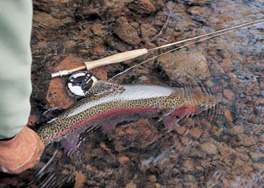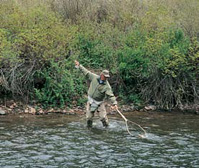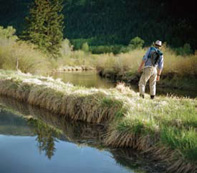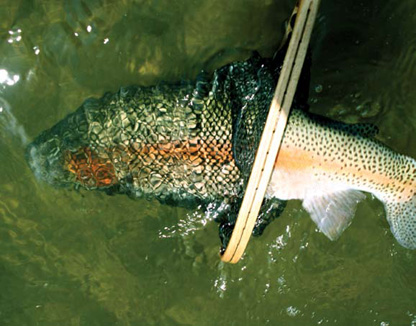Angler Etiquette


catch its most aggressive fish.
Recently the Salt Lake Tribune reported a headline story entitled “Angler Etiquette on the Decline” and “River-rage incident is part of a disturbing trend in a peaceful sport.” On November 13, 2004, one man pulled a handgun to end a heated confrontation. An angler was fishing from a mid-stream rock in Utah’s Green River when a drift boat closely crossed over his fishing hole. Jumping from the rock, the man grabbed the drift boat. An argument ensued that ended when the boat angler drew his gun.
Our streams are not Los Angeles freeways. For many, fly fishing is a way to escape the cities’ crowds. For years fly fishing has been a peaceful sport. But lately the many anglers seeking solitude have taken out their frustration by being combative fishermen.
Fishing etiquette is becoming a thing of the past. Rude behavior is on the increase. Recently I had my prized fly rod outfit shoplifted while I was sitting on my tailgate taking off my waders. I had carefully set it down alongside my vest and while I was busy changing someone stole it. My name was clearly engraved on my rod.
We must put a stop to this rude behavior trend. One of the reasons that I have enjoyed fly fishing for so many years is that my fellow anglers have been so respectful of others.
I have made many friends while fishing a stream. Fly fishermen have been the elite sportsmen. They care for the environment by practicing conservation and they have been helpful and courteous to others.
I have met some rude anglers. One incident occurred along a desert river. My friend and I started to descend a steep rocky trail when we encountered a mass rattlesnake migration. The snakes were everywhere and frightened, we returned back to the truck. I have never witnessed


so many aggressive snakes. As we were preparing to leave, a grumpy angler parked by us and started ragging on us for fishing his favorite spot. He was so rude that we failed to warn him about the rattlers. He started hiking down the trail wearing only shorts and tennis shoes. My friend and I looked at each other smiling. In a few moments the enraged angler returned, upset over our failure to warn him. We left before a brawl could break out. We should have warned him even though he started the ruckus.
Let us return to the days when the fly fisherman was the elite sportsman. Always be respectful of others. Ask before fishing or getting close to another angler. Be friendly and inquire about his success. He may be a helpful source of current information. I’m a prolific fly tier and I commonly give my successful flies away. When I later see the angler he is now a friend and a valuable source of information. Making friends with other anglers is rewarding because I have learned of many new, good places and productive methods.

Let us all be on our best behavior at all times. Do not disturb another angler’s fishing spot. Let him know that you are heading away from where he is fishing. Don’t wade, walk, or boat near his water. Skirt it widely and quietly. Simply follow the “Golden Rule.” It works.
Fly fishermen on the average are highly successful people. Their education level and income are in the top percentiles. Correspondingly our behavior on a stream should match these demographics. Walking too close to a stream bank can alarm the fish and should be avoided. Your silhouette and tramping can cause both alarming sights and vibrations. Find a way to give another angler’s water a wide berth. He will respect you for your actions.
Wading and boating require a detour so that you avoid the area being fished. Pass your boat quietly, well away from their spot. Don’t splash the oars and don’t make waves.
If your water is too crowded, be flexible in your plans by trying another place. Perhaps you may find a more productive location.
Practice strict catch and release. Limit your take to only what you will really use. Obey the laws for they were designed to preserve our fisheries. Biologists’ research data went into their enactments.
Catch and release is simple. First, play the fish in as quickly as possible. I use heavier tippets than most and either small-barbed or non-barbed hooks. Turn the fish upside down because this disorients the fish and reduces struggling. Grab the fly with either forceps or firmly with your fingers. Back the hook out the way it went in. If the barb is being stubborn, press the hook in a little then pull the barb away from

the snagged tissue and pull the hook free. Forceps should be clamped closely to the barbed area. Pull on the fly in a straight path. Return the fish back into the water as soon as possible or better yet remove the hook while the fish is still submerged. Hold the fish upright with its head upstream then give it time to catch its breath. You can aid in its respiration by moving the fish back and forth pumping water through its gills. When revived, the fish readily swims back to deeper water.
A soft landing net is helpful in controlling a fish. Wet hands tend to remove less of a fish’s protective slime coating. This coating is a barrier against viral and bacterial infections so a fish should be handled minimally.
Fish are released so that we can catch them again. Fly fishing is a “Green Sport” that treads lightly on the environment.
Finally, become actively involved in political positions affecting our water’s environment. Study the issues and vote according to what you think is right. Let’s preserve our sport, for it is truly a lifetime one.



© 2025 The Gale Group, Inc. All rights reserved.
© 2025 Perigee Learning LLC. All rights reserved.
LoveTheOutdoors.com is owned and operated by Advameg, Inc. © 2025 Advameg, Inc.
Camping Adventures • Dutch Oven Cooking • Sports Knots
Fly Tying • Freshwater Fishing • Fly Fishing

